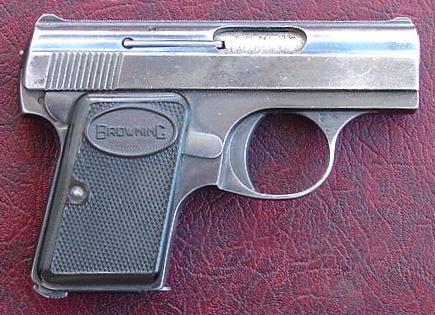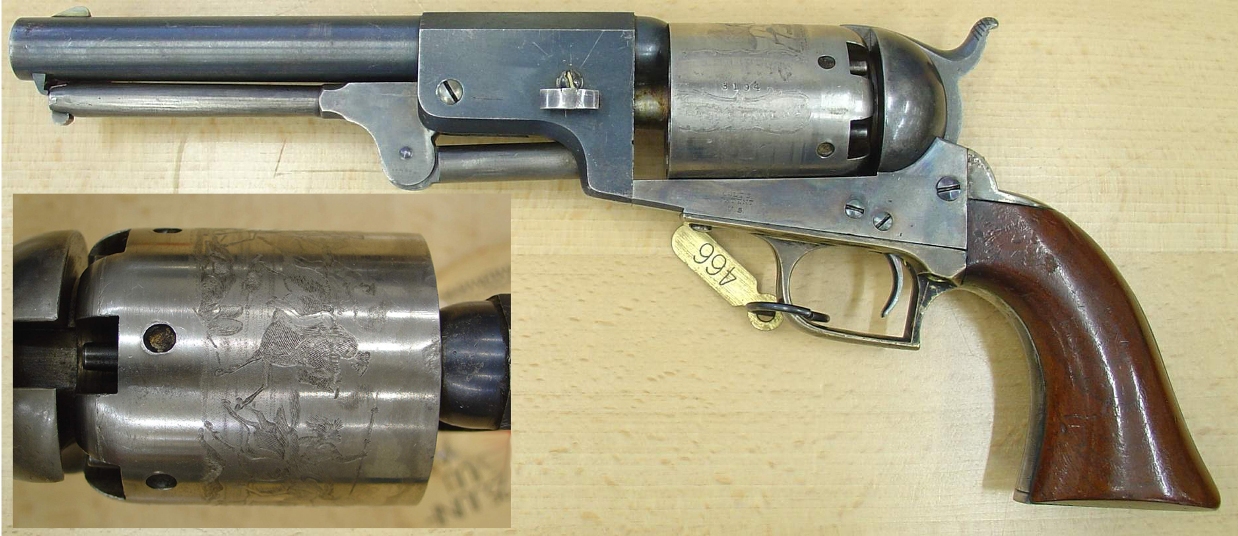|
Pocket Pistol
In American English, a pocket pistol is any small, pocket-sized semi-automatic pistol (or less commonly referencing either derringers, or small revolvers), and is suitable for concealed carry in either a coat, jacket, or trouser pocket. Pocket pistols are sometimes categorized as smaller than sub-compact pistols, but the distinction is not clear-cut as some small sub-compact pistols may be categorized as pocket pistols, and some large pocket pistols may be classified as sub-compact pistols. Pocket pistols were popular in the United States until the 1960s and 1970s when most states passed laws limiting or prohibiting the carry of concealed weapons. However, the passage of "shall issue" firearms license laws in the 1980s and 1990s resulted in a resurgence in the popularity of pocket pistols in the United States, creating new markets for small, simple, reliable, concealed-carry firearms. In general use, the term pocket pistol is purely descriptive, but "mouse gun" (used especiall ... [...More Info...] [...Related Items...] OR: [Wikipedia] [Google] [Baidu] |
Baby Browning
The 1931 Fabrique Nationale (FN) Baby Browning is a small blowback-operated semi-automatic pistol designed by Belgium-born Dieudonné Saive chambered in .25 ACP (6.35x15 mm). The pistol features a six-round magazine capacity and is a striker-fired, single action, blow back mechanism. The manual thumb operated safety locks the slide in the closed position when engaged using side thumb pressure. History FN produced under license from the American arms designer John Browning the revolutionary Model 1905 pocket pistol. Despite the name FN used for this pistol, it was later marketed as the FN 1906, the V.P. .25 (V.P. denoting Vest Pocket), and most confusingly, the Baby. The .25 ACP cartridge became widely available during this time. The term ACP stands for " Automatic Colt Pistol". This cartridge was among the first automatic pistol cartridges to be utilized worldwide. It was designed with a semi-rimmed shell casing made of brass. The rim of the shell casing had a slightly l ... [...More Info...] [...Related Items...] OR: [Wikipedia] [Google] [Baidu] |
Cobra Arms
Cobra Firearms, also known as Cobra Arms and officially as Cobra Enterprises of Utah, Inc. was an American firearms manufacturer based in Salt Lake City, Utah. Cobra Firearms was distantly related to the "Ring of Fire" companies of inexpensive firearms makers and may have been a reincarnation of Raven Arms and possibly Davis Industries. Cobra Arms produced inexpensive handguns. Many firearms manufactured by Cobra Arms were constructed of injection-molded Zamak, a zinc alloy. History Cobra Enterprises of Utah, Inc. filed for chapter 7 bankruptcy February 24, 2020. Derringer production was taken over bBearman Industries Products Cobra Arms primarily manufactured and sold pocket pistols and derringers in .22 LR, .32 ACP, and .380 ACP, however they also market larger handguns in 9mm Parabellum and .45 ACP. All pistols are Zamak alloy unless otherwise noted: Derringers * Cobra Arms Classic series are constructed in .22LR, .22 WMR, .25 ACP, and .32 ACP, * Cobra Arms Titan, a stai ... [...More Info...] [...Related Items...] OR: [Wikipedia] [Google] [Baidu] |
Harrington & Richardson
H&R 1871, LLC, or more commonly known as Harrington & Richardson, is an American brand of firearms and a subsidiary of JJE Capital Holdings. H&R ceased production February 27, 2015. History The original H&R firm was in business for over a century from 1871 to 1986."About Us" by Harrington & Richardson at the H&R 1871 website Frank Wesson, brother of Daniel B. Wesson who co-founded Smith & Wesson, started a firearms manufacturing firm in 1859, sharing an early patent with Nathan Harrington. Wesson produced two trigger rifles and spur trigger pistols ... [...More Info...] [...Related Items...] OR: [Wikipedia] [Google] [Baidu] |
Iver Johnson
Iver Johnson was an American firearms, bicycle, and motorcycle manufacturer from 1871 to 1993. The company shared the same name as its founder, Norwegian-born Iver Johnson (1841–1895). The name was resold, and Iver Johnson Arms opened in 2006, but since it does not manufacture parts or provide information relating to the pre-1993 company, it represents a continuation of it in name only. Iver Johnson Iver Johnson was born in 1841Massachusetts deaths, 1841-1915, Familysearch, https://familysearch.org/pal:/MM9.1.1/NW7D-6LF in Nordfjord, Sogn og Fjordane county, Norway.National Archives and Records Administration, 1872 October 30, ''Index to New England Naturalization Petitions, 1791-1906'', serial M1299, roll 79. He was educated as a gunsmith in Bergen in 1857, and had a gun store in Oslo. Johnson emigrated from Norway to Worcester, Massachusetts, United States in 1863, and continued his work as a gunsmith by trade and an inventor in his spare time. Seeking new and creative ... [...More Info...] [...Related Items...] OR: [Wikipedia] [Google] [Baidu] |
Top-break
Break action is a type of firearm action in which the barrel or barrels are hinged much like a door and rotate perpendicularly to the bore axis to expose the breech and allow loading and unloading of cartridges. A separate operation may be required for the cocking of a hammer to fire the new round. There are many types of break-action firearms; break actions are universal in double-barrelled shotguns, double-barrelled rifles, combination guns, and are also common in single shot pistols (especially derringers), rifles, shotguns, and can also be found in flare guns, grenade launchers, air guns, and some older revolver designs. They are also known as hinge-action, break-open, break-barrel, break-top, or, on old revolvers, top-break actions. Description Break action The first break-action revolver was patented in France and Britain at the end of December in 1858 by Devisme. A substantial hinge pin joins the two parts of the rifle or shotgun; the stock with its firing mechanism and ... [...More Info...] [...Related Items...] OR: [Wikipedia] [Google] [Baidu] |
38 S&W
The .38 S&W, also commonly known as .38 S&W Short (it is sometimes referred to as .38 S&W Short to differentiate it from .38 Long Colt and .38 Special), 9×20mmR, .38 Colt NP (New Police), or .38/200, is a revolver cartridge developed by Smith & Wesson in 1877. Versions of the cartridge were the standard revolver cartridges of the British military from 1922 to 1963. Though similar in name, it is not interchangeable with the later .38 Special due to a different case shape and slightly larger bullet diameter. History The round was first introduced in 1877 for use in the S&W .38 Single Action. As standard for the era, it featured heeled bullet with the same diameter of bullet and case neck equal to .38 inch; later versions discarded the feature and downsized the bullet, but the designation didn't change. After World War I, the British military sought to replace pre-war revolvers with easier-to-handle weapons. Webley demonstrated a lighter version of their Mk III revolver with mo ... [...More Info...] [...Related Items...] OR: [Wikipedia] [Google] [Baidu] |
32 S&W
The .32 S&W cartridge (also known as the .32 S&W Short) was introduced in 1878 for Smith & Wesson pocket revolvers. It was originally designed as a black powder cartridge. The .32 S&W was offered to the public as a light defense cartridge for "card table" distances. Design Originally designed by the Union Metallic Cartridge Company (UMC) as a black powder cartridge using nine grains of black powder, the round has been loaded with smokeless powder exclusively since 1940. It is low-powered and perfect for use in small frame concealable revolvers and derringers. The round remained popular in the United States and Europe long after the firearms chambered for it were out of production. At one time, it was considered to be the bare minimum for a self-defense round and was judged unsuitable for police work. For defensive uses, the .32 S&W is grouped with other turn-of-the-century cartridges designed for use in "belly guns"—guns meant for use in point-blank defensive situations, such a ... [...More Info...] [...Related Items...] OR: [Wikipedia] [Google] [Baidu] |
Smith & Wesson Safety Hammerless
The Smith & Wesson Safety Hammerless or Smith & Wesson New Departure (nicknamed by collectors as the Lemon Squeezer) is a double-action revolver that was produced from 1887 to 1940 by Smith & Wesson. Based on the Smith & Wesson Model 2 double-action design, the revolver incorporated an internal hammer and an external grip safety on its back-strap. It was chambered in .32 S&W and .38 S&W calibers; these revolvers were discontinued prior to World War II, being eclipsed by the stronger hand ejector models. .32 and .38 Safety Hammerless models The Smith & Wesson .38 Safety Hammerless models were produced from 1887 (1888 for the 32) to just before World War II. They were chambered in either .32 S&W or .38 S&W with a five-shot cylinder. They were most often produced with a 2-inch, 3-inch, or 3.5-inch barrels; but some 6" barrelled versions are known to exist. These top-break revolvers were designed for fast reloading and concealed carry as the hammer was internal and would not sn ... [...More Info...] [...Related Items...] OR: [Wikipedia] [Google] [Baidu] |
Colt's Manufacturing Company
Colt's Manufacturing Company, LLC (CMC, formerly Colt's Patent Firearms Manufacturing Company) is an American firearms manufacturer, founded in 1855 by Samuel Colt and is now a subsidiary of Czech holding company Colt CZ Group. It is the successor corporation to Colt's earlier firearms-making efforts, which started in 1836. Colt is known for the engineering, production, and marketing of firearms, most especially between the 1850s and World War I, when it was a dominating force in its industry and a seminal influence on manufacturing technology. Colt's earliest designs played a major role in the popularization of the revolver and the shift away from earlier single-shot pistols. Although Samuel Colt did not invent the revolver concept, his designs resulted in the first very successful ones. The most famous Colt products include the Colt Walker, made in 1847 in the facilities of Eli Whitney Jr., the Colt Single Action Army or Peacemaker, the Colt Python, and the Colt M1911 pist ... [...More Info...] [...Related Items...] OR: [Wikipedia] [Google] [Baidu] |
Colt Single Action Army
The Colt Single Action Army (also known as the SAA, Model P, Peacemaker, or M1873) is a Trigger (firearms)#Single-action, single-action revolver handgun. It was designed in 1872 for the U.S. government service revolver trials of 1872 by Colt's Patent Firearms Manufacturing Company (today known as Colt's Manufacturing Company) and was adopted as the Service pistol, standard-issued pistol of the US Army in 1873 until 1892. The Colt SAA has been offered in over 30 different calibers and various Gun barrel, barrel lengths. Its overall appearance has remained consistent since 1873. Colt has cancelled its production twice, but brought it back due to popular demand. The revolver was dubbed as "Colt Peacemaker" and is a famous piece of Americana (culture), Americana, as it was popular with ranchers, lawmen, and outlaws alike since its creation and due to its association with the American Wild West era. Today, they are mainly bought as memorabilia by collectors and Historical reenactment ... [...More Info...] [...Related Items...] OR: [Wikipedia] [Google] [Baidu] |
Snubnosed Revolver
A snubnosed revolver (colloquially known as a snubbie, belly gun, or bulldog revolver) is a small, medium, or large frame revolver with a short barrel, generally less than 4 inches in length. Smaller such revolvers are often made with "bobbed" or "shrouded" hammers and there are also "hammerless" models (where the firing pin is entirely internal); the point is to allow the gun to be drawn with little risk of it snagging on clothing. Since the external movement of the mechanism is minimal or nil, shrouded and hammerless models may be fired from within clothing. The design of these revolvers compromises range and accuracy at a distance in favour of manoeuvrability and ease of carry and concealment. Snubnosed revolvers were extremely popular in the United States until the 1950s and 1960s when many states passed laws limiting or prohibiting the concealed carry in the United States, carrying of concealed weapons. The passage in many US states of "shall issue" firearms licence laws from ... [...More Info...] [...Related Items...] OR: [Wikipedia] [Google] [Baidu] |







